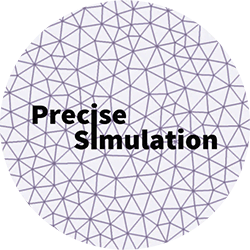
|
FEATool Multiphysics
v1.17.5
Finite Element Analysis Toolbox
|

|
FEATool Multiphysics
v1.17.5
Finite Element Analysis Toolbox
|
EX_HEATTRANSFER2 1D Stationary heat transfer with radiation.
[ FEA, OUT ] = EX_HEATTRANSFER2( VARARGIN ) NAFEMS T2 benchmark example for heat transfer with radiation [1]. The left end of a 0.1 m rod is held at a temperature of 1000 K while the right end is radiating with an emissivity, em = 0.98, and Stefan-Bolzmann constant, sigma = 5.67e-8 Wm^2/K^4.
+---------- L=0.1m ----------+ T(0.1)? T=1000K q_n = em*sigma*(T_amb^4-T^4)
The rod is made of iron with density 7850 kg/m^3, heat capacity 460 J/kgK, and thermal conductivity 55.563 W/mK. The steady state temperature at the left end is sought when the surrounding ambient temperature is 300 K.
[1] The Standard NAFEMS Benchmarks,
The National Agency for Finite Element Standards, UK, 1990.
Accepts the following property/value pairs.
Input Value/{Default} Description
-----------------------------------------------------------------------------------
hmax scalar {0.02} Grid cell size
sfun string {sflag1} Finite element shape function
solver string fenics/{} Use FEniCS or default solver
istat scalar {1}/0 Use stationary (=1), or time dependent solver
iplot scalar {1}/0 Plot solution (=1)
.
Output Value/(Size) Description
-----------------------------------------------------------------------------------
fea struct Problem definition struct
out struct Output struct
cOptDef = { 'hmax', 0.02;
'sfun', 'sflag1';
'solver', '';
'istat', 1;
'iplot', 1;
'fid', 1 };
[got,opt] = parseopt(cOptDef,varargin{:});
% Grid generation.
L = 0.1;
nx = round(L/opt.hmax);
fea.grid = linegrid( nx, 0, L );
% Problem definition.
fea.sdim = { 'x' }; % Space coordinate name.
fea = addphys( fea, @heattransfer ); % Add heat transfer physics mode.
fea.phys.ht.sfun = { opt.sfun }; % Set shape function.
% Equation coefficients.
fea.phys.ht.eqn.coef{1,end} = 7850; % Density
fea.phys.ht.eqn.coef{2,end} = 460; % Heat capacity.
fea.phys.ht.eqn.coef{3,end} = 55.563; % Thermal conductivity.
fea.phys.ht.eqn.coef{6,end} = { 1000 }; % Initial temperature.
% Boundary conditions.
fea.phys.ht.bdr.sel = [ 1 4 ];
fea.phys.ht.bdr.coef{1,end} = { 1000 [] };
fea.phys.ht.bdr.coef{4,end}{2}{4} = '0.98*5.67e-8';
fea.phys.ht.bdr.coef{4,end}{2}{5} = 300;
% Parse physics modes and problem struct.
fea = parsephys(fea);
fea = parseprob(fea);
% Compute solution.
if( strcmp(opt.solver,'fenics') )
fea = fenics( fea, 'fid', opt.fid, 'nproc', 1, ...
'tstep', 10, 'tmax', 1000, 'ischeme', 2*(~opt.istat) );
else
if( opt.istat )
fea.sol.u = solvestat( fea, 'fid', opt.fid, 'init', {'T0_ht'} );
else
[fea.sol.u, tlist] = solvetime( fea, 'fid', opt.fid, 'init', {'T0_ht'}, ...
'tmax', 1000, 'tstep', 10 );
end
end
% Postprocessing.
if( opt.iplot>0 )
postplot( fea, 'surfexpr', 'T', 'axequal', 0 )
title('Temperature')
xlabel('x')
ylabel('T')
end
% Error checking.
T_sol = evalexpr( 'T', 0.1, fea );
T_ref = 926.97;
out.err = abs(T_sol-T_ref)/T_ref;
out.pass = out.err<6e-4;
if( nargout==0 )
clear fea out
end